Shared Space—Collective Practices
Art Omi
Ghent, New York
A show on the community-engaged projects of four architecture collaboratives based in the U.S., Central America, and England, Shared Space—Collective Practices, was on view at outdoor sculpture park Art Omi in the Hudson Valley for the first half of 2023. Organized by Art Omi architecture curator Julia van den Hout, the exhibition within in the Newmark Gallery revisited a form of social activist design work known as urban interventions that emerged in the mid-to-late 2000s: a way of organizing small-scale projects to activate vacant spaces, advocate for social and political issues, and serve historically discriminated-against and economically disadvantaged groups.
Featuring a selection of projects by WIP Collaborative, FUNdaMENTAL Design Build Initiative, Colloqate Design, and Assemble, the show exhibited photos and videos documenting the four practices in the gallery of Art Omi’s stone-and-glass-walled visitor’s center, designed in 2008 by Ghent, New York–based FT Architecture & Interiors. A series of sloping, multicolored platforms with varying surface textures designed by WIP is the center point of the gallery. The colorful platforms are being reused after the show in the organization’s education pavilion.
The four collaboratives share a style familiar to many community-oriented design initiatives: ad hoc, colorful, joyful, and often temporary, they react to the unique situation of a place and engender a sense of belonging among residents normally ignored by government programs and private finance-led redevelopment. They create places of identification and inspiration that signal intangible, unseen possibilities. While the scale of these projects can often seem inadequate in the face of larger-scale systemic and institutional failures, the work has a self-evident value. They serve as pilots, models, examples, and inspirations, change agents stimulating others to act, and opportunities to expand the imagination for people with little exposure to art and design. They can have substantial results when adequately funded and expanded into policymaking regimes. And the collaborations with community members can be incredibly fun, meaningful, and rewarding.
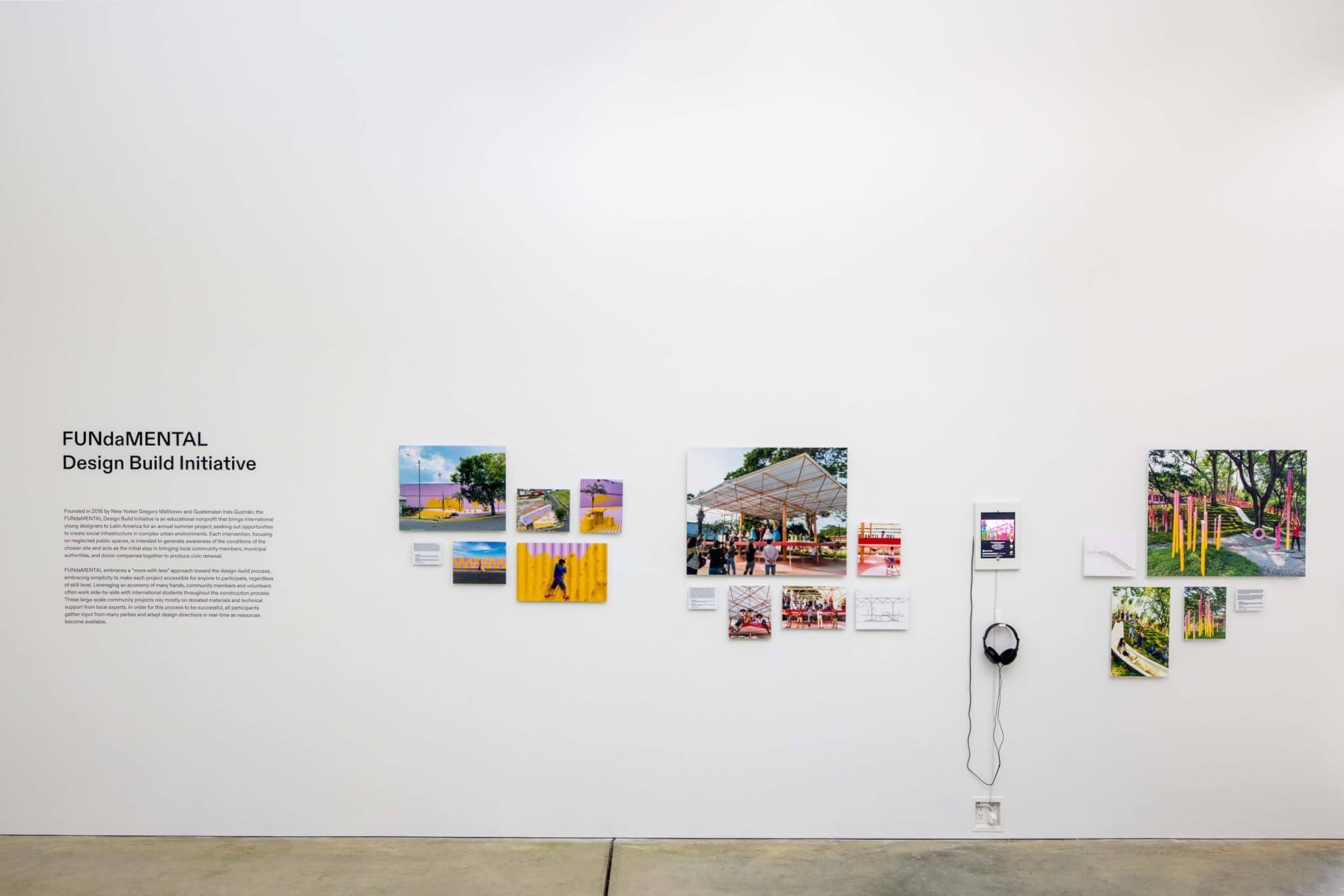
FUNdaMENTAL Design Build Initiative
The projects of FUNdaMENTAL Design Build Initiative on view began in 2016 as a series of summer projects in Guatemala, Costa Rica, and New York as part of an effort to create what the group calls “social infrastructure.” FUNdaMENTAL was founded by Gregory Melitonov and Guatemalan-native Inés Guzmán in 2016, who met while working for Renzo Piano Building Workshop in Genoa, Italy and started their own office, Taller KEN, in 2013. The firm first collaborated with a large group of designers and residents to build a public plaza in an impoverished neighborhood of Guatemala City in 2017. Shown as a series of mounted photos accompanied by a short descriptive wall text, the Barrio Gerona project draped fabric diagonally across a defunct rail line to offer shading and a sense of identity, and adorned the wall alongside a stretch of low-rise housing with murals designed by local children.
The projects selected for the exhibition often intervene to serve transitional or under-served communities, such as a migration hub in Tapachula, Mexico, near the border of Guatemala, where two years ago, FUNdaMENTAL built an open-air theater and play space that includes an elevated stage with a thin rooftop for events, performances, and shading, and a sloping playscape of ropes for kids to climb beneath the stage. Another project in Costa Rica shown in the exhibition through mounted photos was a planted landscape of brightly painted bamboo poles color-coded used to call attention to air pollution, resulting a uniquely beautiful place within a San José public park.
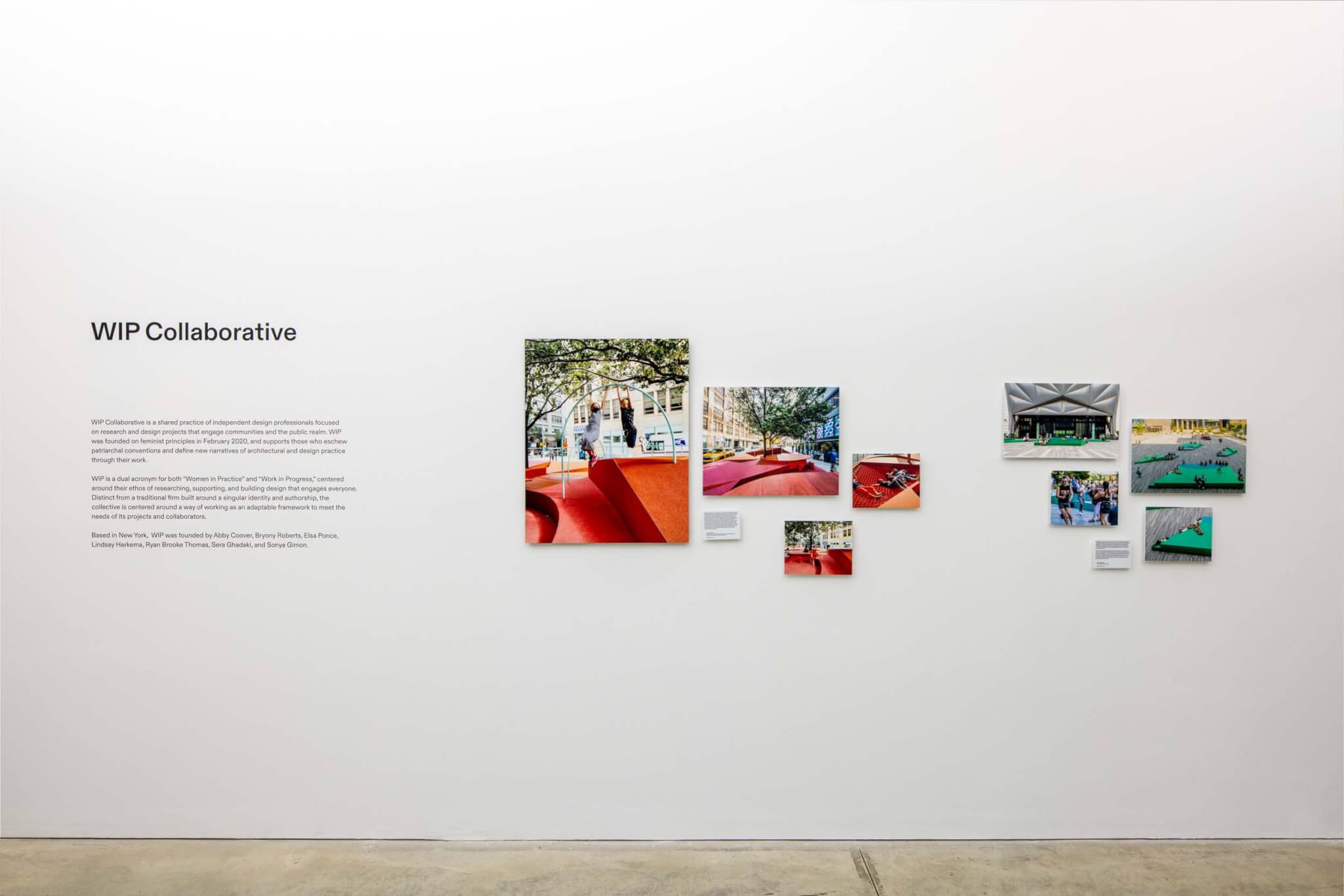
WIP Collaborative
WIP Collaborative stands out as a collective of female designers identifying as an independent, feminist group. Abby Coover, Bryony Roberts, Sera Ghadaki, Lindsay Harkema, Elsa Ponce, Sonya Gimon, and Ryan Brook Thomas work together under the WIP umbrella, though each also have their own private architecture offices. (WIP stands for both “works in progress” and “women in practice.”) Founded in 2020, the group has two projects in the show represented by mounted photos documenting the site-based interventions. Both were temporary public plaza installations that used assemblages of colorful platforms, mixing zones for relaxation, play, and gathering. One was created in the space made by Diller Scofidio + Renfro’s rolling Shed structure when retracted, and the other at Hudson Square, north of TriBeCa. Both are clearly products of the COVID-19 pandemic, expressing the sensibility at the time that outdoor public spaces had greater valence than previously recognized. Cities had taken these spaces for granted, but WIP showed how outdoor spaces could be easily and effectively expanded to promote care and healing.
After several years of these kinds of initiatives, many practitioners of temporary urban interventions tend to yearn for the capacity to create more long-lasting, better-funded, larger-scale projects that would operate less on the margins and gain support from government agencies, or even instigate new institutions. In the case of New Orleans–based Colloqate, critique of institutions and thinking about how to systematically address structural problems has been at the center of the group’s work from the beginning.
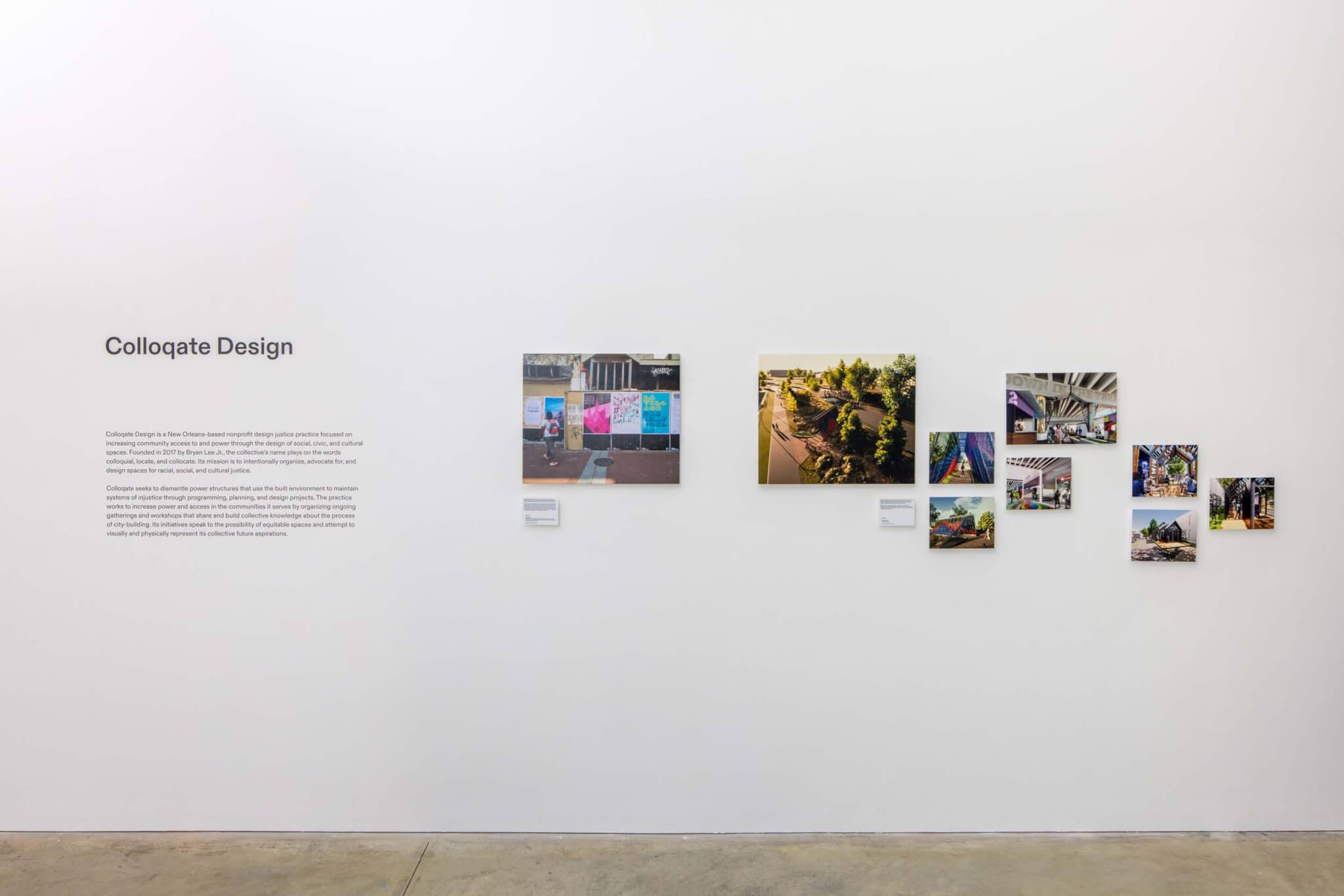
Colloqate
Also shown as a series of mounted photos and videos, accompanied by an installation of stacked protest signs, the work of Colloqate, founded in 2017 by Bryan Lee Jr., focuses on advocating for design justice for Black lives. The projects exhibited include Blights Out, an early collaboration with a group of partners calling attention to the negative effects of property exchange and redevelopment in Black communities, composed of a series of posters on plastic yard signs characterizing market-based housing as class warfare. A poetic video shows three activists bearing the signs. In 2021, its Tactical Protest Signs for Black Lives Matter, shown as a stacked installation of the signs, reverberated the need for a fundamental rethinking of institutions like the police and prison system. Storia is a series of mounted renderings depicting civic spaces Colloqate designed starting in 2019 to honor neighborhood stories in New Orleans and to build connections supportive of the aspirations of residents.
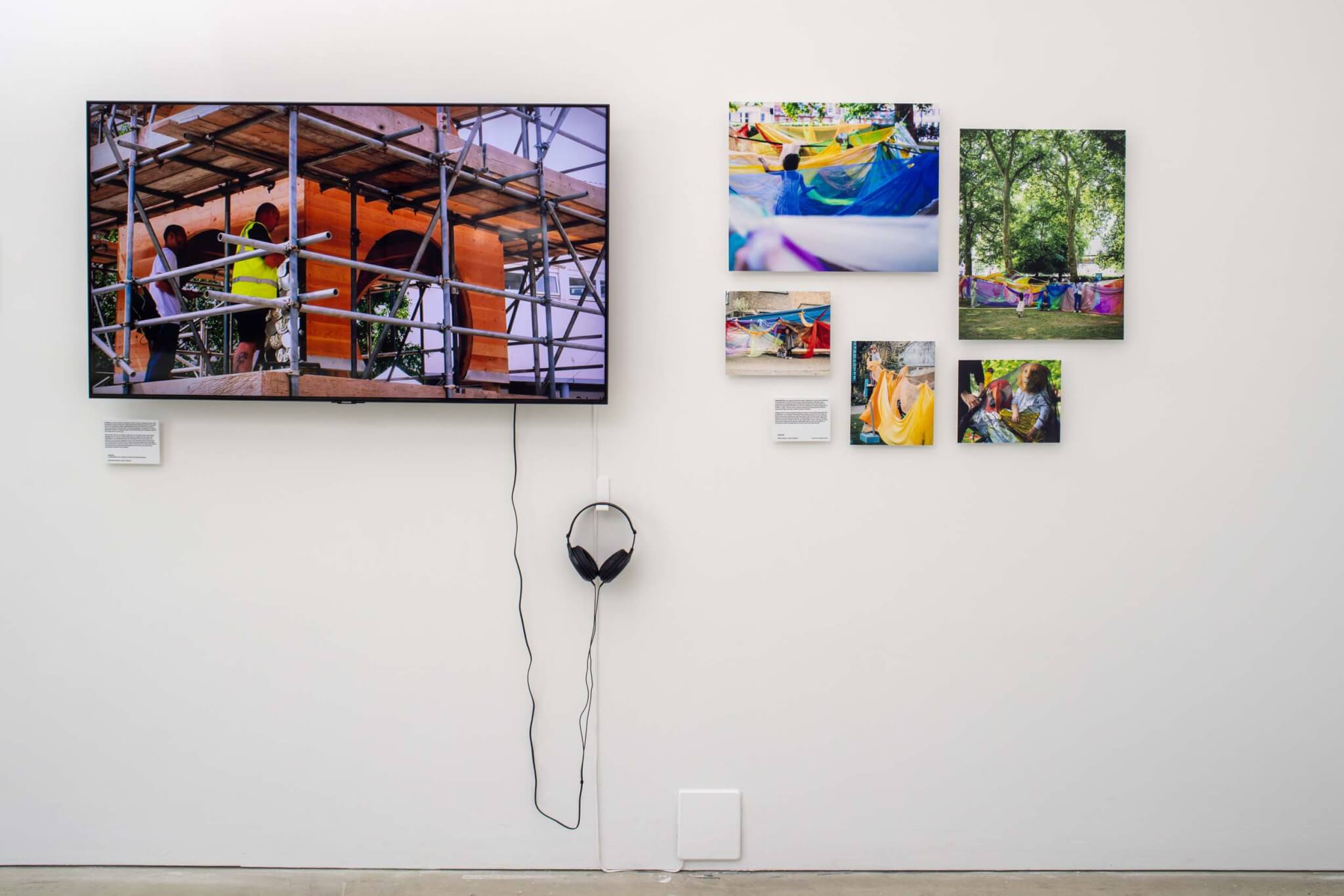
Assemble
The most well-known of the groups represented in Shared Space—Collective Practices may be Assemble. Founded in 2010, one of the firm’s longest-lasting and most extensive projects, 10 Houses on Cairns Street, is on view through photographic documentation. To complete this project, Assemble worked with residents in Granby, Liverpool and Bermondsey, London to reclaim vacant buildings and convert them into affordable homes in 2021. A video documenting the project showcases how the group utilized streetscape design, murals, street furniture, planting, and paving to reinvigorate a central place in the two communities. Also on view is the Assemble Play project. For the last five years, the studio has been designing play spaces for children based on the theory of Playwork, in which children are able to freely create their own play environments with a collection of loose parts that can be moved around, carried, rolled, lifted, stacked, and combined to produce novel experiences.
Neither collaboration nor social advocacy work is exclusive to small nonprofit organizations and informal collectives, of course: all architectural work is essentially collaborative. Teams of designers with different experiences, skills, and insights create groundbreaking projects due to cross-disciplinary collaborations among engineers, builders, economists, and researchers. By themselves, the effect of these collaborations is often fairly minimal in comparison to the scale of the problems they seek to address.
Shared Space—Collective Practices succeeded in using attractive images, renderings, videos, and concise descriptions to document these divergent collective and collaborative practices, invoking what small-scale architecture and design projects can accomplish: address neglected and disenfranchised communities. The exhibition conveyed the beauty and creative potential of the transformation of places. But architecture exhibitions should also be required to do more placemaking within the gallery itself to accommodate different user groups and give them spaces to read and process the wall texts, videos, and images commonly displayed. These photographic displays take time to absorb, so galleries need to meet the visitor halfway and offer a place to dwell for a minute or two.
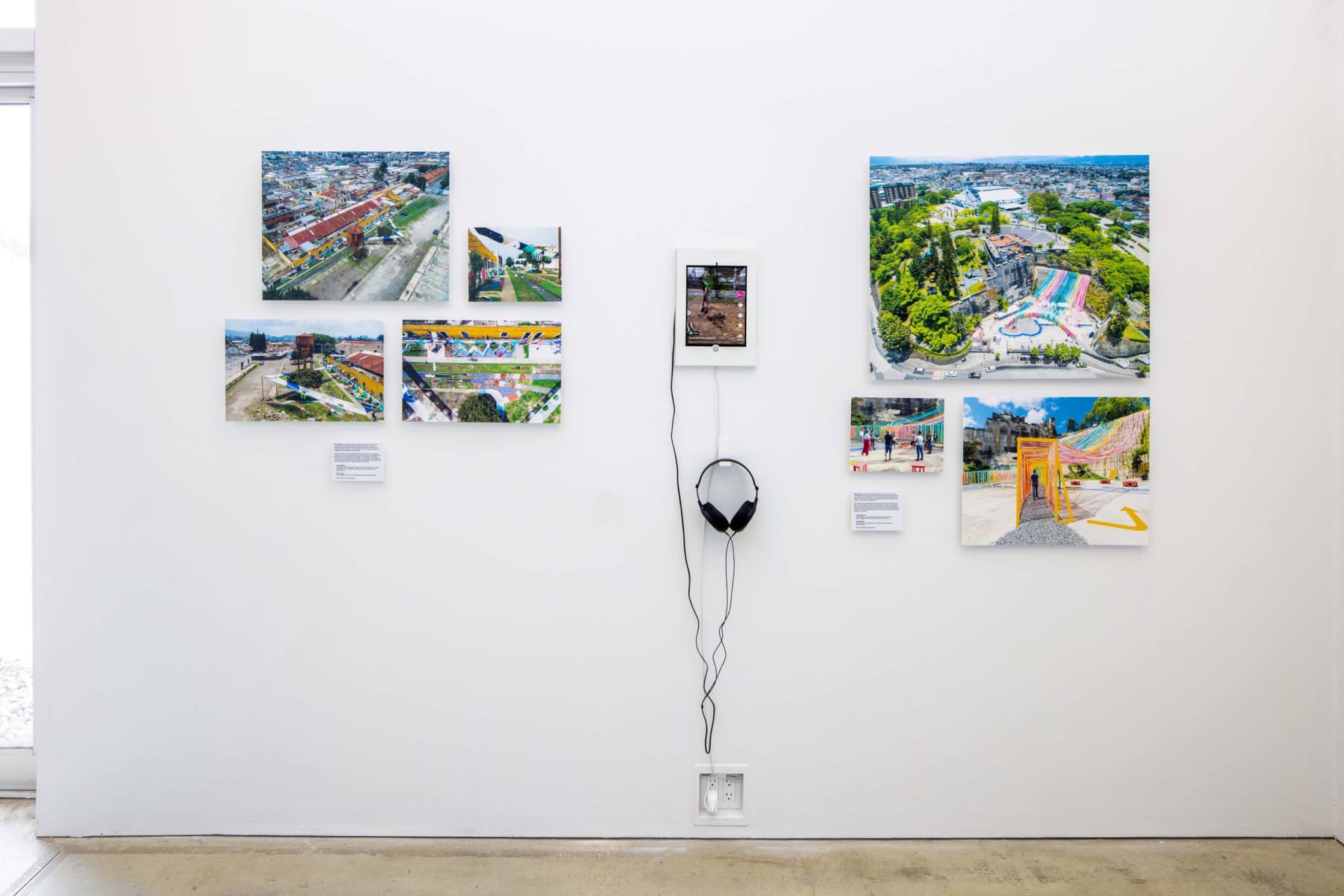
The promise of ad hoc collective experiments like the ones shown at Art Omi is being borne out most evidently by the extensive new policymaking reshaping national and international rulemaking around climate change to reduce energy consumption in buildings and to require sustainable materials. These policy changes were preceded by decades of small-scale pioneering projects of committed individuals and groups, proving concepts for green buildings, passive homes, and environmental building standards. Yet if everyone agrees that collaborative, community-led design projects have an outstanding social value, they should be supported with substantial funding from the government. Dollars should be widely available for every community to use art and design to build places reflecting their visions for themselves.
Stephen Zacks is an advocacy journalist, architecture critic, urbanist, and project organizer based in New York City.











